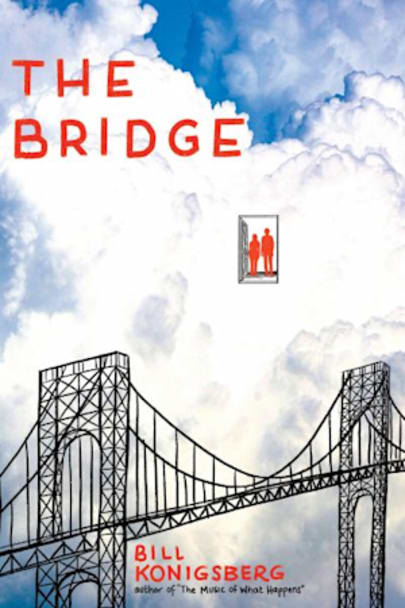Aaron and Tillie don’t know each other, but they are both feeling suicidal, and arrive at the George Washington Bridge at the same time, intending to jump. Aaron is a gay misfit struggling with depression and loneliness. Tillie isn’t sure what her problem is — only that she will never be good enough. On the bridge, there are four things that could happen: Aaron jumps and Tillie doesn’t. … Tillie doesn’t.
Tillie jumps and Aaron doesn’t.
They both jump.
Neither of them jumps.
Or maybe all four things happen, in this astonishing and insightful novel from Bill Konigsberg.
more



Teens Aaron and Tillie had never met before. That is, not until they meet on the bridge, in the final moment of their lives. There, on the George Washington Bridge, they share a glance at their final decisive moment. There, they also encounter another person who does understand.
This book is interesting. It gives us four stories, four ways their story could end. In presenting these ways, the book shows the impact of suicide as well as the impact of survival. It is encouraging and optimistic. It does not make light of depression. It accepts that it is difficult and, at times, impossible. It also gives us hope that it can be overcome.
This is a topic that is difficult to approach, but it is one that must be approached. I applaud Mr. Konigsberg for confronting this subject.
I received a free copy of this book in exchange for an unbiased review.
The Bridge could have been too heavy to contemplate. The story is about two teens who meet on the George Washington Bridge on the day both of them have decided that life isn’t worth living. The plot then explores several realities from that point. One jumps, the other jumps, they both jump, neither of them jumps. When I realized this—about a third of the way through the book, I was kind of bowled over. No, I hadn’t read the cover copy before I started. The book was by one of my favorite authors. I quite often pick up books by my favorites and dive in without any preparation. It’s an interesting way to read.
The Bridge is simultaneously one of the saddest and yet most joyful books I’ve ever read. I cried for these kids, but I also laughed with them. I felt their pain, and that of their siblings, parents, and friends. I heard their voices. They weren’t just telling me their story, though. They were telling me mine.
I’ve never felt so lost that I went looking for a bridge, but I do know what it’s like to believe you’re not enough, and never will be. I don’t know if that’s an adolescent thing? I’m thinking not, because as an adult with a creative career, I’m faced with the question of “Is it enough?” every time I finish writing something.
I might not have appreciated The Bridge as fully back when I was in high school as I do now. It may have been too close or too real. But I think it’s an important book and one that should be read. Not simply because it shows understanding and compassion, or for the solutions one might find between the pages, but for the exploration of how suicide affects those who are left behind. The friends, but also the parents—which brings me to my final note.
Aaron’s father, Michael, is a wonderful, wonderful character. While I empathized with Tillie’s mom, Michael captured my heart. I loved his involvement with MKP and how his brothers supported him through every eventuality. It was just so healthy and an absolute pleasure to read.
Thank you Edelweiss and Scholastic for this advanced reader copy of The Bridge by Bill Konigsberg.
I saw Bill Konigsberg speak on a YALLWest panel about this novel and knew I had to read it. The concept of a “sliding doors” type narrative of two suicidal teens on the George Washington Bridge ticks a lot of boxes: mental health issues, LGBTQ youth, suicide and life (and death) in Manhattan.
I will say right off that this book is messy. Life is messy. Death is messy. Being a teenager is messy. But back to the book. Between the alternating POV’s of the two main characters, the four different outcomes (she jumps/he doesn’t, he jumps/she doesn’t, they both jump and neither jumps) plus the POV of their friends and family what I thought would be a tight suspenseful novel is a sprawling 400 page ocean of thoughts and feelings. A few times I felt myself lost in the grief and minutiae of everyone’s thoughts and daily routine and ready to climb out. But I will also admit that I’m glad I stuck it out until the end. Although the story was more complicated and meandering than I was prepared for it is an important story to tell. The fact is that suicide is now the second leading cause of death in youth aged 15-24 and The Bridge shows how some of these kids are not beyond reach. That their pain can be conquered and managed and that their loss can have far reaching effects to the people that love them and maybe the world.
I highly recommend The Bridge to anyone that is interested in reading about teen depression and suicide but also LGBQT issues, online bullying and parental absence/emotional neglect.